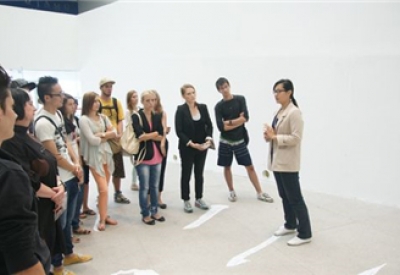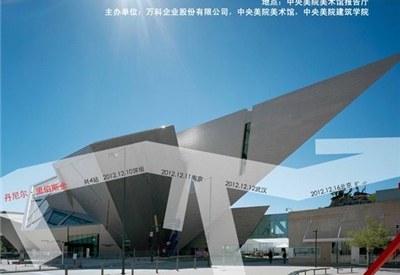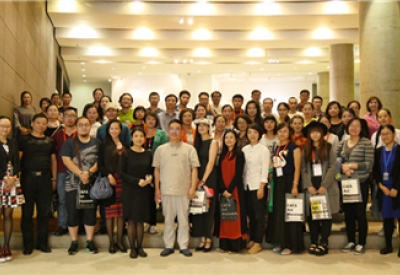

The museums in National Mall in Washington, D.C. in late autumn
The “Overseas Training Program of Museum Education and Curation”, funded by the China National Arts Fund, hosted by the CAFA and American Alliance of Museums (AAM), and organized by Art Management and Education College of CAFA and CAFA Art Museum, was offered in Washington, D.C. from November 7th, 2017. Participants of the program had an in-depth communication with the professionals from the American museum community. Senior educators and experts from the Smithsonian Institution and its museum group, National Gallery of Art, Washington International School and Project Zero have presented the trainees with high-quality academic exchange courses on museum education and curation.


Ms. Andrea Neighbors from the Asia Pacific American Center in Smithsonian Institute was giving a lesson
On November 7, the trainees visited the Asian Pacific American Center in the Smithsonian Institute, where Ms. Andrea Neighbors applied Collaboration with Artists and Community Involvement: Cultural Laboratory as the topic to discuss how academic institutions could get involved in social communities through art. The Smithsonian Asia Pacific American Center has long been focusing on the development of the Asia-Pacific art in the United States. It has brought art into the social communities through the form of "Culture Laboratory". As an innovative way of museum education, it has attracted the attention and curiosity of the trainees and made the discussion to a climax with good questions. The trainees conducted an in-depth discussion on "Cultural Laboratory" as well as the particularity and commonality of the development of the Chinese and American museums. After the course, Ms. Megan Lantz, global program manager of the American Alliance of Museums, welcomed the arrival of the program and all the participants.

Ms. Megan Lantz (the third from the right) and the project members

Ms. Patricia Rodewald was giving a lecture


Mr. Jim Reese from the Washington International School was giving a lecture

A Group photo was taken at the Smithsonian Institution
On the afternoon of the same day, Mr. Jim Reese, who comes from the Washington international school, presented a fascinating Project Zero lecture with his assistant.Mr. Jim put the focus on “thinking”, and emphasized creativity, critical ability and a global vision in educational work. He and his team started with the artwork itself and use examples to demonstrate how to “think” in the museum’s artistic education. They have been working on connecting education and art more effectively. The lecture offered trainees an interactive experience and inspired them with this learning style.
A lecture by Ms. Elizabeth Eder, the National Museum of Asian Art. The trainees were studying artworks in the China Hall of the National Museum of Asian Art.




The trainees participating in a mock audience tour guide at the China Hall of the National Museum of Asian Art
At 10 a.m. on November 8, the trainees visited the National Museum of Asian Art.Ms.Elizabeth Eder, the head of the Education Department at Freer Gallery of Art and Arthur M. Sackler Gallery, made a lecture on “global competitiveness” at the exhibition hall. Using Project Zero’s thinking method and leading the trainees to appreciate Chinese bronze artworks and calligraphy and painting works visually, she introduced the way of letting those who are not familiar with Chinese art can have a quick understanding of it through a short guided tour. Then, Ms. Elizabeth Eder and the museum’s senior volunteers guided and shared the museum’s ancient Chinese bronze art and calligraphy and painting art. In the simulated real scene, the trainees were pretended to be the audience who know nothing about Chinese art, and after an efficiently guided tour, they got a better understanding of Chinese art and culture. The trainees said that this method could be used as a reference and adopted by Chinese museums.

Inside the Washington Portrait Gallery



Workshop experience at the Smithsonian American Art Museum
In the afternoon, the students visited Washington Portrait Gallery and Smithsonian American Art Museum, two of the important museums that represent American Art in the same building, becoming a beautiful landscape of the city. Ms. Briana Zavadil White, the director of the Faculty and students programs at Smithsonian Institution, and Phoebe Hillemann, the tutor of the teachers’association, guided the students to experience the artworks of the museum. They divided the trainees into two groups for the two museums separately and conducted a workshop on thinking of one crucial artwork in the exhibition hall. Under the guidance of the tutor, the trainees actively participated in the studio, turning from receiving information to raising questions. Through constantly thinking, describing and group-discussing, the trainees were greatly inspired by the experience of recognizing and understanding an unfamiliar American artwork from the superficial to the deep.


The conference site of the fellows and teachers of the museum education
After the visiting and the workshop, the trainees discussed with the fellows and teachers of the museum education department, including Patricia Rodewald, Jim Reese, Elizabeth Eder and Billy Anna Zawati White, Phoebe, Hillman and Chinese teachers from schools in Washington. Ms. Elizabeth Eder gave a unique introduction to the digitization of the national museum of Asian art and pointed out that the digitized presentation and dissemination of the artworks will be a general trend. While Chinese teachers from Washington schools took teaching Chinese course in the United States as an example to share how they guided the American students to better learn Chinese and Chinese culture through historical monuments and cultural objects. The two sides made in-depth discussions on the educational cooperation and resource sharing between Chinese and American museums as well as the cooperation between universities and museums. Both China and the U.S. said they had benefited from the discussion.
That night, the trainees also went to the National Gallery of Art in Washington to attend the “educator’s night”. The event was organized by the Public Education Department of the National Gallery, aiming to gather museum educators from all over the United States and arrange special pre-exhibition activities for them as a tribute to all those who work in the museum field. During the event, all the trainees and other educators attended the special exhibition “Vermeer and His Contemporary Masters” after listening to an academic lecture. In the beautiful violin performance of the exhibition, the trainees finished the first half of their study in Washington.

The exterior of the National Gallery in Washington

The group photo was taken in front of the National Gallery in Washington

The event site of the “Educator's Night” in the National Gallery in Washington

One snapshot of the music performance of the “Educator’s Night” in the National Gallery of Washington
The intensive training course in Washington roused the enthusiasm and active participation of the students. It was different from the New York curriculum that focuses on the practicality and operability of museum education. The course in Washington was more about the guidance and creation of thought, and the further exploration and improvement in thinking. It has led students to deeply think about the museum’s education method and public education project design to introduce innovative ideas into museum curation and education, creating a diversified public education mode.







2012-09-26

2012-12-12

2015-09-11
